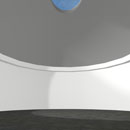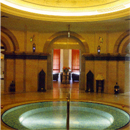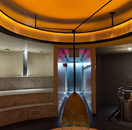
pantheon
A Pantheon, like its namesake cirucular temple in Rome, is a round room with a domed ceiling, used in lobbies and resort and spas. more
pantheon | Resort & Spa
application
Pantheon in resorts and spas is modeled after the earliest European bathhouses, is a round room that uses oculi or other ceiling treatments to draw attention upward.
research
In many cultures, the act of bathing is considered to be a spiritual experience, whereby both body and mind are purified. The architectural prowess and visual ascendancy of ancient rotundas inspired awe from patrons; the acoustical effects of a round, often domed space, were unique in their repetition of soft echoes, making rotundas an ideal space for ethereal sound. The Pantheon in Rome, the namesake for this category of design, is the paramount example of ancient temples that utilized the roundness for a sense of grandeur and the reverberation of prayer, which translated for bathhouses into the echo of water. The inherent connect between personal and spiritual was reasserted by the proximity of prayer and bathing centers, as “the area behind the (Pantheon) Rotunda was occupied by one of those great bathing establishments that were one of the chief delights of the ancient Romans. The Pantheon was probably first built in connection with these Baths and was to have had its entrance from them.”1
Furthermore, the circularity of interior bathing spaces served a practical purpose, as the form allowed heat to disperse evenly around the room.2 Turkish hammams, which have their roots in Roman bathhouses and their limbs in contemporary spas, utilized rounded and domed shapes to capture and circulate heat and steam. Native American sweat baths employed a simplified form of bent branches and animals skins to achieve the same effect.3
The oculus, or other punctures of the building skin at the apex of the dome, provided a flow of fresh air – a rudimentary air exchange system. Although contemporary oculi are rarely open to the elements, their transparent glass or enclosed light fixtures produce a similar effect in terms of offering a zenith of visual interest and, most importantly, lighting the space. At night, candles or oil lamps were used to light the rotundas, imparting an organic, yet mystical light quality.
Because of the inherent visual and acoustic properties of the rotunda, the form has remained a prevalent fixture in resort and spa design. Although continually employed by the Ottomans in hammams dating back to the 14th century, European architects began reproducing rotundas around the 19th century, with the neoclassical revival of Roman baths via domed ceilings, arches, and columns.4 Bathhouses across Austria, Germany, and Czechoslovakia melded Roman architecture and European aesthetic with the inclusion of glass and metals.
Domed lobbies and dining rotundas became commonplace in grand hotels across the United States, but they were not utilized as pool or spa areas until the mid to late 20th century. Grand hotels such as the Ponce DeLeon Hotel (1889) highlighted rotundas in public interior spaces with electric lights, stained glass, and expensive furniture.5
Architects took note, following the resurgence of personal wellness and spa visits in the 1980s and 1990s, and captured the Roman lifestyle in rotunda rooms around the world. Upon their reincarnation, historic materials like stone were accompanied by glass tile, exotic wood, and polished concrete. Lighting became the most dominant feature in Pantheon spaces, both from the oculus and ambient effects. Architect Shawn Hausman utilized the oculus as the dominant element in The Standard Miami (2006), with the rest of the space bathed in passive blue light. In the Oriental Spa at the Landmark (2005) in Hong Kong, China, designer Peter Remedios used fiber optics in the ceiling plane to mimic the night sky, as seen through an oculus. In rotunda rooms with water features, the pool is round and centered in the space, directly below the oculus. Often, the pool is lit from beneath the water, as was the case in Wilson & Associates’ One & Only Royal Mirage (2002) in Dubai, United Arab Emirates. This strategy serves both the purpose of reflecting light from the cavity, as well as reinforcing the significance of the oculus.
The Pantheon ideal, inspired by the architectural relic, has been relatively unaltered despite its prolific reinterpretations, as illustrated in this intype. The contemporary material and lighting applications serve as mere enhancements of the original design features, and enable rotunda spaces to continually support a bathhouse approach to modern resort and spa facilities.6
end notes
- 1) Jeffrey W. Limerick, “The Grand Resort Hotels of America” Perspecta 15 (1975): 95-6.
- 2) Leonard Koren, Undesigning the Bath (Berkeley, CA: Stone Bridge Press, 1996), 72.
- 3) Leonard Koren, Undesigning the Bath, 69.
- 4) John C. Paige and Laura Soulliere Harrison, Out of the Vapors: A Social and Architectural History of Bathhouse Row--Hot Springs National Park, Arkansas (Washington, D.C.: U.S. Department of the Interior, National Park Service, 1988), 8.
- 5) Limerick, "The Grand Resort Hotels of America," 95-96.
- 6) Evidence for the archetypical use and the chronological sequence of Pantheon in resort and spa was developed from the following sources: 1920 Lobby, Arizona Biltmore Hotel [1929] Albert Chase McArthur; Phoenix, AZ in “Four Hotels: Taken in Context,” Architectural Record 168, no. 1 (July 1980): 118-121 / 1960 Cocktail Lounge, Colony Motor Hotel [1960] Irving Salsbert, Ralph LeBlanc and Maxwell Co.; Swampscott, MA in “Hotel on a Hill,” Interior Design 31, no. 8 (Aug. 1960): 88-92 / 1990 Lobby, The Palace of the Lost City [1992] WATG; Sun City, Bophuthatswana in “African Extravaganza,” Hospitality Design Magazine 15, no. 4 (May 1993): 38; Restaurant, Bellagio [1998] Jerde Partnership International, Atlandia Design Group, Thomas Design Group; Las Vegas NV in “Bellagio,” Hospitality Design Magazine 21, no. 2 (March 1999): 114; Lobby, The Royal Towers at Atlantis [1998] WATG; Paradise Island, Bahamas in “The Royal Towers at Atlantis,” Hospitality Design Magazine 21, no. 5 (July 1999): 59; Lobby, Hotel Excelsior [1999] BDA/SRL; Rome, Italy in “Gold Key Winners: Suites,” Hospitality Design Magazine 21, no. 8 (Nov. 1999): 78; Lobby, Venetian Resort Hotel and Casino [1999] WATG; Las Vegas NV in “Merchants of Venice,” Interior Design 70, no. 12 (Oct. 1999): 216-17 / 2000 Steam Room, ESPA Center at Victoria-Jungfrau Grand Hotel and Spa [2003] Behles and Partners; Interlaken, Switzerland in “Swiss Haiku,” Hospitality Design Magazine 26, no. 6 (Aug. 2004): 68-69; Spa, Grandhotel Bellevue Gstaad [2003] Eric Reichenbach and Gottfried Hauswirth; Gstaad, Switzerland in Spa Design (Koln: Daab, 2006): 252; Spa, Oriental Spa at the Landmark [2005] Peter Remedios; Hong Kong, China in Spa Design (Kohn: Daab, 2006), 362; Spa, The Standard Miami [2006] Shawn Hausman; Miami FL in Spa Design (2006): 46-47; Lobby, Grand Hyatt Hotel [2006] Ai Design Group; Atlanta, GA in “Casual Elegance,” Hotel Design Magazine (Feb./March 2006): 16-19; Pool, Willow Stream Spa at Fairmont Banff Springs [2006] Kerry Busby Interior Design; Calgary, Alberta, Canada in “Trend Lines: Spas,” Hotel Design Magazine (June/July 2006): 20; Spa, The Standard Miami [2006] Shawn Hausman; Miami FL in Spa Design, 45; Spa, One and Only Royal Mirage [2002] Wilson and Associates; Dubai, UAE in Kunz, Spa Design, 362; Sauna, Tschuggen Bergoase Spa [2006] Mario Botta; Arosa, Switzerland in Relax: Interiors for Human Wellness (Boston: FRAME, 2007): 22.
bibliographic citations
1) The Interior Archetypes Research and Teaching Project, Cornell University, www.intypes.cornell.edu (accessed month & date, year).
2) Goldfarb, Rachel. “Theory Studies: Archetypical Practices of Contemporary Resort and Spa Design.” M.A. Thesis, Cornell University, 2008, 31-38.


